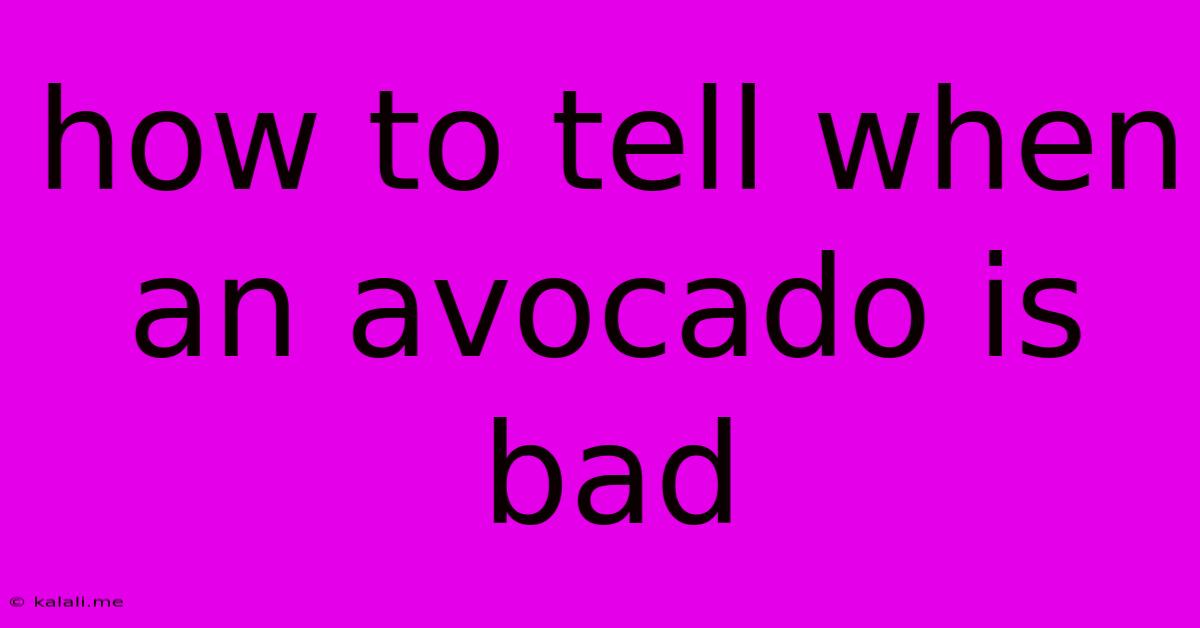How To Tell When An Avocado Is Bad
Kalali
May 29, 2025 · 3 min read

Table of Contents
How to Tell When an Avocado is Bad: A Guide to Ripe and Rotten Avocados
Avocados are a delicious and versatile fruit, but knowing when they're ripe and ready to eat can be tricky. Buying avocados that are too hard or too soft can lead to disappointment, so learning how to identify a good avocado is crucial for enjoying this creamy delight. This guide will teach you how to tell when an avocado is bad, ensuring you only use the freshest avocados in your guacamole, toast, or salad.
Understanding Avocado Ripeness:
The key to a perfect avocado is understanding the difference between ripe and overripe. A ripe avocado will yield gently to pressure, indicating its creamy texture inside. Conversely, a bad avocado will show signs of spoilage. Let's explore the different ways to tell if your avocado is past its prime.
Visual Clues: What to Look For
-
Color: While avocado color varies depending on the variety (Hass avocados are typically dark purplish-black when ripe), a general indicator of ripeness is a rich, deep color. However, color alone isn't definitive. Avoid avocados that show significant browning or discoloration. Patches of brown or black spots, especially large ones, are a sign of decay.
-
Stem: Gently pull the small stem off the avocado. If the underlying flesh is green and firm, your avocado is likely ripe. If it's brown and mushy, then it's overripe.
-
Texture: Gently squeeze the avocado in your hand. A slightly soft feel indicates ripeness, but a very soft or mushy feel suggests it's overripe and potentially bad. Avoid avocados that feel spongy or unusually firm. Extremely hard avocados are underripe and won't have the desired creamy texture.
Smell Test: The Ultimate Indicator
Sometimes, visual cues aren't enough. The best way to check for spoilage is to give your avocado a sniff. A ripe avocado will have a mild, slightly nutty aroma. A sour or unpleasant odor is a clear sign that the avocado has gone bad. This smell is often accompanied by browning or discoloration.
Signs of a Bad Avocado:
- Significant browning or blackening of the flesh: This is a strong indicator of spoilage, particularly if it extends beyond surface level.
- Mushy texture: If the avocado feels excessively soft or mushy, it's likely overripe and past its prime.
- Unpleasant odor: A sour or fermented smell is a definitive sign that the avocado has gone bad and should be discarded.
- Mold growth: Any visible mold on the avocado indicates significant spoilage and should be avoided.
How to Extend the Life of Your Avocados:
- Proper Storage: Store unripe avocados at room temperature to allow them to ripen. Once ripe, store them in the refrigerator to slow down the ripening process.
- Freezing: Avocados can be frozen for later use, preventing waste. Simply mash ripe avocados and store them in airtight containers.
- Lemon Juice: To prevent browning, add a squeeze of lemon juice to cut avocados. This will help maintain their freshness.
By understanding these visual, tactile, and olfactory clues, you can easily identify ripe and ready avocados, avoid those that have gone bad, and make the most of your avocado purchases. Remember, paying attention to detail will ensure you enjoy every creamy bite!
Latest Posts
Latest Posts
-
How To Tan A Deer Hide
May 30, 2025
-
How Can You Get Chewing Gum Off Clothes
May 30, 2025
-
Too Good To Be True Spanish
May 30, 2025
-
Move Asset To Another Artboard Illustrator
May 30, 2025
-
If Else Helms Template Compare Strings
May 30, 2025
Related Post
Thank you for visiting our website which covers about How To Tell When An Avocado Is Bad . We hope the information provided has been useful to you. Feel free to contact us if you have any questions or need further assistance. See you next time and don't miss to bookmark.